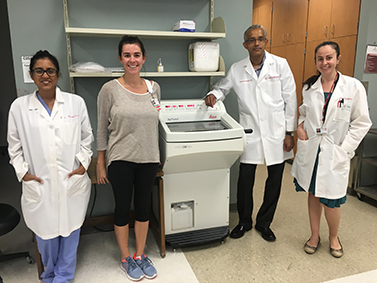Cryostats and Microtomes and LN2 Tanks… Oh My!
Holy Moly, science geeks unite! It is raining ex citing equipment over here in our lab. Well, we’re excited about it anyway, so we’d love to get you up to date so that you too can feel the thrill. Through the wonderful generosity of some of our most loyal grantors, the KTB has recently acquired a brand new LN2 tank, a microtome, and a cryostat. Now, that’s all well and good you might say, but what on earth are those things and what do they do? Why should I be so fired up about them? Read on.
citing equipment over here in our lab. Well, we’re excited about it anyway, so we’d love to get you up to date so that you too can feel the thrill. Through the wonderful generosity of some of our most loyal grantors, the KTB has recently acquired a brand new LN2 tank, a microtome, and a cryostat. Now, that’s all well and good you might say, but what on earth are those things and what do they do? Why should I be so fired up about them? Read on.
Through grants from the Catherine Peachey Fund, we were able to purchase a microtome and a cryostat. A microtome is a desktop sized tool used to cut extremely thin slices of material (tissue), known as sections, as part of the preparatory process for staining, observation, etc. It is used to cut tissue embedded in paraffin blocks, which are kept at room temperature. You can think of it like a deli slicer.
The cryostat is for the shared use of Dr. Natascia Marino (KTB BCRF Investigator in Breast Cancer Research) and her team, as well as other breast cancer researchers at IU. A cryostat works by keeping frozen tissue samples stable at a low temperature while cutting them into slices as thin as a few micrometers. You can think of it like a deli slicer (or a microtome!) inside a freezer. The cold temperature of the tissue must be maintained while it’s being cut. The thin slices of tissue are then laid onto slides. Depending on the type of slide, the slide can be used for microdissection or to visually determine the presence of specific molecules. Prior to having our own cryostat, we had to take all of our samples to the IU Pathology lab for cutting (sectioning), which of course took longer. Having our own equipment means we can be much more efficient.
An LN2 (shorthand for liquid nitrogen) tank stores tissue at -190° C. We are running out of room in our old one, and needed a new one on hand for the great day when we fill the first one, which now contains slightly fewer than 14,000 tissue cores and cryopreserved tissue. Our new tank was purchased from funds granted to us by BCRF.
Please join us in thanking the Catherine Peachey Fund and BCRF, for making it possible for us to continue to grow in our mission to prevent breast cancer.